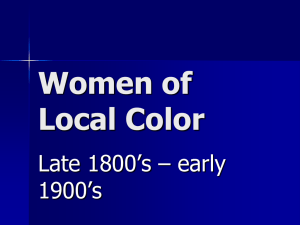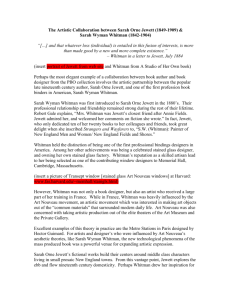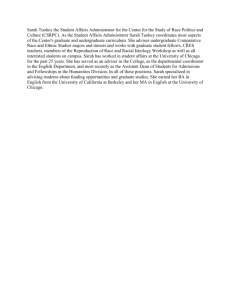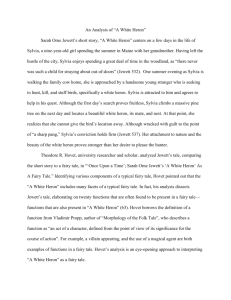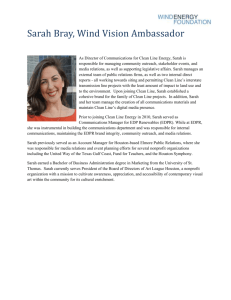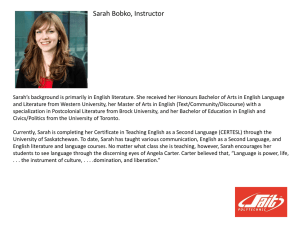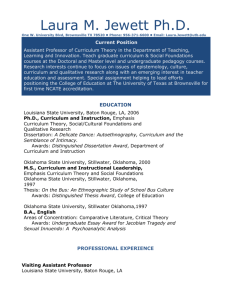Sarah Orne Jewett Biography
advertisement
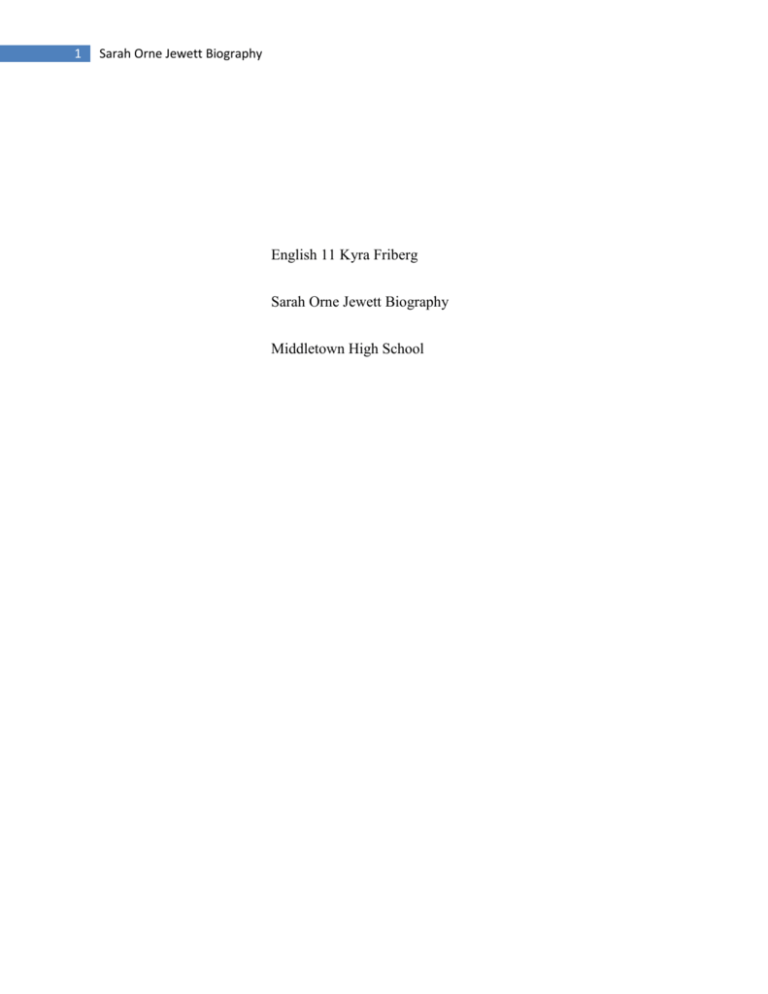
1 Sarah Orne Jewett Biography English 11 Kyra Friberg Sarah Orne Jewett Biography Middletown High School 2 Sarah Orne Jewett Biography For Sarah Orne Jewett, she had a tough life growing in the late 1800’s she was different because of her boldness of accepting her sexuality as a homosexual. Her surroundings of books in her home allowed her to be influenced by what she read. She grew, “virtually fed on words”, quickly becoming drawn into writing. Her talent was something that she strived to become an even better writer. Oddly enough the characters in her stories are portrayed to have strong meaning for their existence which is something Sarah tried to achieve. Her difference in her preference for love is something that affected her work greatly. Her works have been criticized for weak narratives. Sarah Orne Jewett was born in 1849, into the family of Dr. Theodore H. Jewett and Caroline Perry Jewett, living most of her life in South Berwick, Maine. During her childhood, she was chronically ill, but graduated from Berwick Academy, three years later, publishing her first book, “Jenny Garrow’s Lovers” (Heller, 2008). This was the beginning of her career as a writer and she soon met Annie Fields, another writer. They traveled together around from England to America, both eager to meet other writers, such as Mark Twain, Mary E. Wilkins Freeman, Rudyard Kipling and many others (Heller, 2008). In her later years, she and her sister had gotten into a carriage accident the day of her birthday. Her sister, simply bruised but for Sarah, she received a concussion and some damage to the neck. This costed her writing career for her inability to concentrate. This lasted for seven years until her death at her childhood home in South Berwick, Maine. 3 Sarah Orne Jewett Biography Her works are composed of fictional stories, pertaining to her time period where the character has a strong sense of fate and is used to contemplate the unexplored regions of the mind. She also discusses the role of woman and “helps to delineate a strong tradition of lesbian, bi-sexual, gay, and trans-writing, a tradition often buried under heterosexual male criticism and canon-formation of the twentieth century” (Gale Student Resources in Context, 2008). This could be a possible reason for why so many people enjoy her work. Her household gave her access to many literary works in her family’s library. She based most of her books around the setting of her rented cottage in South Berwick, Maine, including fishermen, the saltwater harbor and the coastal inhabitants (Gale Student Resources in Context, 2008). Of Jewett’s works, she included many books and poetry which were not as popular as they are today in the late 1800’s. This author wrote not for the people, but for herself, she wanted to get a point across and that point was “the acceptance of difference” (Gale Student Resources in Context, 2008). To show this in her books “that difference focuses on the abilities of country people, lest townspeople should think them slow or having little to offer” (Gale Student Resources in Context, 2008). The themes within her works are female strength and independence for them. Another theme described is the ability of women, “the need to realize these abilities without prejudice” and the role of how males cover up the traditions of a different sexuality (Gale Student Resources in Context, 2008). Stories mentioned, as follows are written by her, “"A White Heron," the story of a young country girl whose circumscribed world is invaded by a male hunter from the larger world in search of a "specimen," is not only the story of Sylvy protecting the natural world, but also, as Judith Fetterley has pointed out, the story of Sylvy's rejection of the economy of heterosexuality” 4 Sarah Orne Jewett Biography (Gale Student Resources in Context, 2008). Another is, “"Martha's Lady," perhaps the most explicitly lesbian of Jewett's published short stories, as Marjorie Pryse notes, looks at class issues and issues of "marriageability" as important to women's ability to live the lives they might choose” (Gale Student Resources in Context, 2008). There is also, “The Country of the Pointed Firs”, “as in Jewett's most famous book, The Country of the Pointed Firs, often called her masterpiece. The Country of the Pointed Firs centers on women: Almiry Todd, a sibyl and healer with whom the narrator of this book is in wonderful sympathy; Mrs. Blackett, Almiry's mother, whose isolated life on Greene Island with her son William, who is both son and daughter to her, fits her well; Poor Joanna, who, disappointed in love, became a recluse living her days out on Shell Heap Island, representing for the narrator the hermit who lives in all of our lives” (Gale Student Resources in Context, 2008). These are perfect examples of Jewett’s literary famous work. The genre of most of Jewett’s works was basically fictional. Her style has loosely written narratives where the character has a strong sense of fate. Also the characters are portrayed to search for acceptance amongst others. “Her books discuss love and connections that go beyond the physical into the realm of the spiritual” (Gale Student Resources in Context, 2008). Her way of writing reflects her values and point of view of the world as “the heterosexual world that robbed women of opportunity, showing over and over again in her fiction that the modern economy was pathological for women” (Gale Student Resources in Context, 2003). Most people that are not interested in the works of Jewett’s work were “predominantly white, male, heterosexual group of critics and scholars” (Ammons). It seemed that only recently Jewett’s works were found and had begun to be read. With her story, “The Country of Pointed 5 Sarah Orne Jewett Biography Firs” she was able to create a “special connection” in which the readers could pick up on (Salmonson, 2011). Her other stories were considered “weird tales… lacking that special connection with so important a work as Firs, have been afforded even less of a chance of achieving recognition." ((Salmonson, 2011). Many critics observed her work as a “feminist document” (eNotes, 2011). For “A White Heron”, critics noticed personal importance within the text. “Although critics debate various interpretations and the effectiveness of Jewett's efforts, they agree that “A White Heron” is worthy of study.” (eNotes, 2011). The significance of Sarah Orne Jewett was her impact on the views of her readers and how it changed their way of thinking about differences of people. “Jewett's writing is especially important to lesbian readers, critics, and writers who are looking for a caring past.” (Swartz, 2003). Jewett constantly destroys the boundaries of gender difference. It is this that makes her work such a great additional piece to our American History. In conclusion, Sarah Orne Jewett is a great asset to our many American writers. She tried to achieve the acceptance of difference of “a strong tradition of lesbian, bi-sexual, gay, and transwriting, a tradition often buried under heterosexual male criticism and canon-formation of the twentieth century” (Gale Student Resources in Context, 2008). She hoped to change the views of others in order to rise above the gender differences and become equal to man. 6 Sarah Orne Jewett Biography References: Ammons, E. (n.d.). Sarah orne jewett (1849-1909). DeRoche, C. (1996). Sarah Orne Jewett: Her World and Her Work. Gale Student Resources In Context. eNotes. (2011). “A White Heron” Sarah Orne Jewett. Sarah Orne Jewett A White Heron Criticism. Retrieved from http://www.enotes.com/short-story-criticism/white-heronsarah-orne-jewett Heller, T. (2008, February 8). Sarah orne jewett text project. Roman, M. (1992). Sarah Orne Jewett: Reconstructing Gender. Tuscaloosa, Alabama: The University of Alabama Press. Salmonson, J. (2011). Criticism about Sarah Orne Jewett. Sarah Orne Jewett (1849 - 1909). Retrieved from http://www.ipl.org/div/litcrit/bin/litcrit.out.pl?au=jew-197 Swartz, P. (2003). Sarah Orne Jewett: Overview. Gale student resources in context. (2008, July 14). Sarah Orne Jewett.

